Introduction:
Other pages on this website have dealt with rigid and flexible construction methods for sett paving. The methods and materials used to joint setts are often used with other forms of stone paving, such as flagstones , cubes and cobbles and imported stone flags , and the same (or very similar) techniques may also be used with their concrete equivalents, such as concrete flags , patio flagstones , and rigid-laid block pavers .
This section of the website considers four differing materials used to joint stone pavements, namely...
Due to the amount of information, each of the above options are covered on separate pages, and the information provided for cement mortars is further sub-divided into pages dealing with different types of cement mortar (notably site-mixed mortars and proprietary mortars ) as well as different application techniques.
Aesthetic considerations:
The jointing of a stone pavement can have a dramatic effect on the finished appearance of the work, completely changing its character, in some cases. The chosen jointing should never detract from the stone by being more dominant visually - after all, the mortar, pitch or grit-fill costs a fraction of what the stone is worth, and you want to see where the money has gone, not the ancillary materials! A good jointing material will complement the stone, offering a small degree of contrast that emphasises the individual stone element, neither dominating nor disappearing, but simply getting on with job in a quiet and understated manner.

Materials:
While a light coloured mortar (cement or resin based) can accentuate a dark coloured sett, it can look messy with a light coloured pavement. The dark nature of pitch/bitumen looks great with most materials, but can get soft and sticky on the very hottest of days; not something you'd want on a heavily pedestrianised precinct regularly trafficked by Ladies' fashion heels. A loose filled joint is not an effective deterrent to weeds, and is not recommended for sett work where joints of 6mm or greater are anticipated.
In days gone by, the highest quality stone paving would be finally sealed with molten pitch, while work of a lower aesthetic quality would be filled with some loose material, such as ash, or possibly a lime-based mortar. The modern trend is for a high-strength mortar pointing for rigid pavements and sand or grit sealing for flexible.
For residential and other 'light-duty' sett paving, the traditional approach of molten pitch (modified bitumen) is still very effective, both visually and structurally, and is much more convincing on 'heritage' or olde-worlde styled projects. We find that the pitch complements the setts perfectly, and will re-seal any cracks that appear once the hot summer sun comes out of hiding and partially re-melts the pitch. Sett paved roads and driveways we have laid in this manner have remained free of any weeds for many, many years, and look far more 'authentic' than modern mortar-pointed sett pavements.
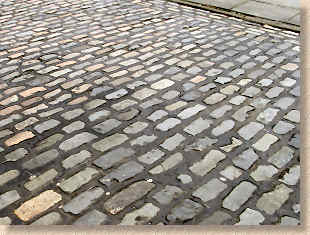
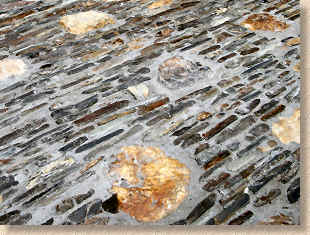
The cement mortar pointing method is more fraught. Accidental spillages of mortar or careless cleaning-up can stain the paving; any jointing cracks caused by minor movement of the stone elements cannot re-seal unaided, as does pitch, and site-mixed cement-based mortars can perish over time by the actions of mosses, lichens, and general wear and tear.
For commercial and specification projects, the current trend is to use a proprietary jointing mortar. These products are pre-batched under controlled conditions off-site, and, assuming they are installed according to the manufacturers' recommendations, they give a guaranteed quality of joint. BS7533:12 gives a list of desired qualities for cement-based mortars, but does not consider resin-based mortars, which are quite popular in Ireland and continental Europe and gaining in popularity in Britain.
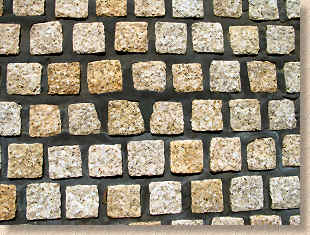
In summary, careful thought must be given to the choice of jointing to ensure it meets the requirements of the project.
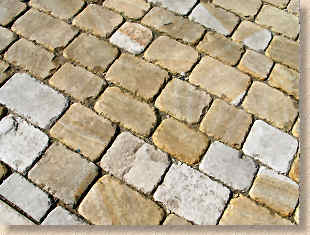
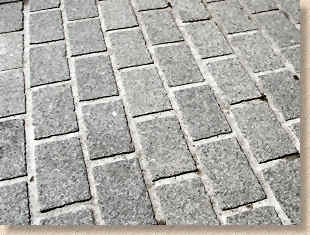
Other pointing and jointing pages...
- Introduction
- Terms & definitions
- Pointing Styles
- Spacers for Paving
- Cement Mortars
- - Hand Pointing
- - Pointing Riven Flagstones Using Coloured Mortar: A Case Study
- - Wet Grouting
- - Dry Grouting
- - Slurry Grouting
- - Gun Grouting
- - Poured Grouting
- Resin Mortars
- - Polymerics
- - GftK Polymerics: A Product Study - VDW 840+
- - Romex Polymeric Mortars: A Product Study
- - Jointex Polymeric Mortar: A Product Study
- - Slurries
- - GftK Slurry Mortars: A Product Study - VDW 800 Permeable
- - GftK Slurry Mortars: A Product Study - VDW 850
- Re-jointing paving
- Pitch Jointing
- Loose Fill Jointing
- - Stabilisation
- Alternative Jointing Materials
